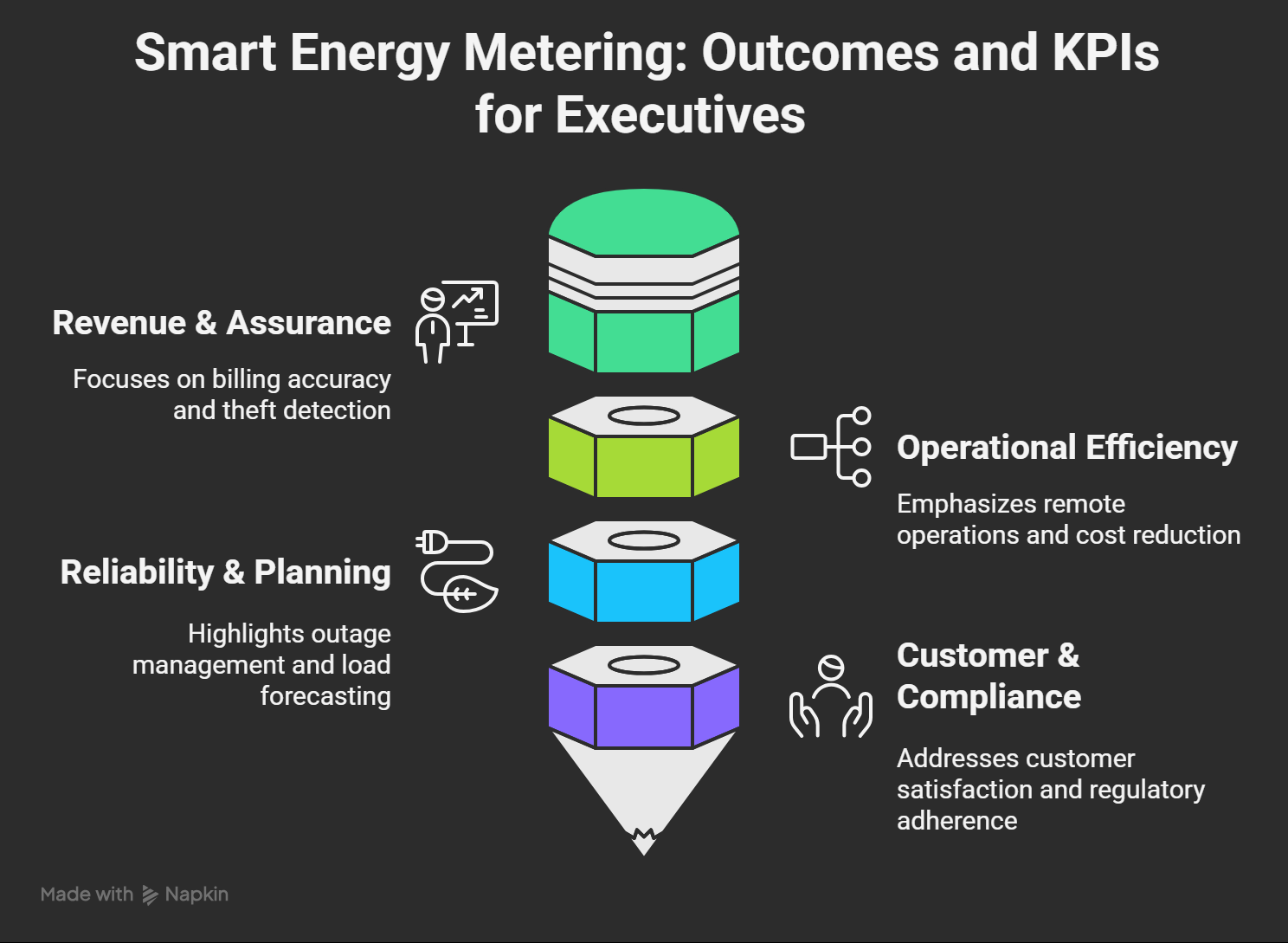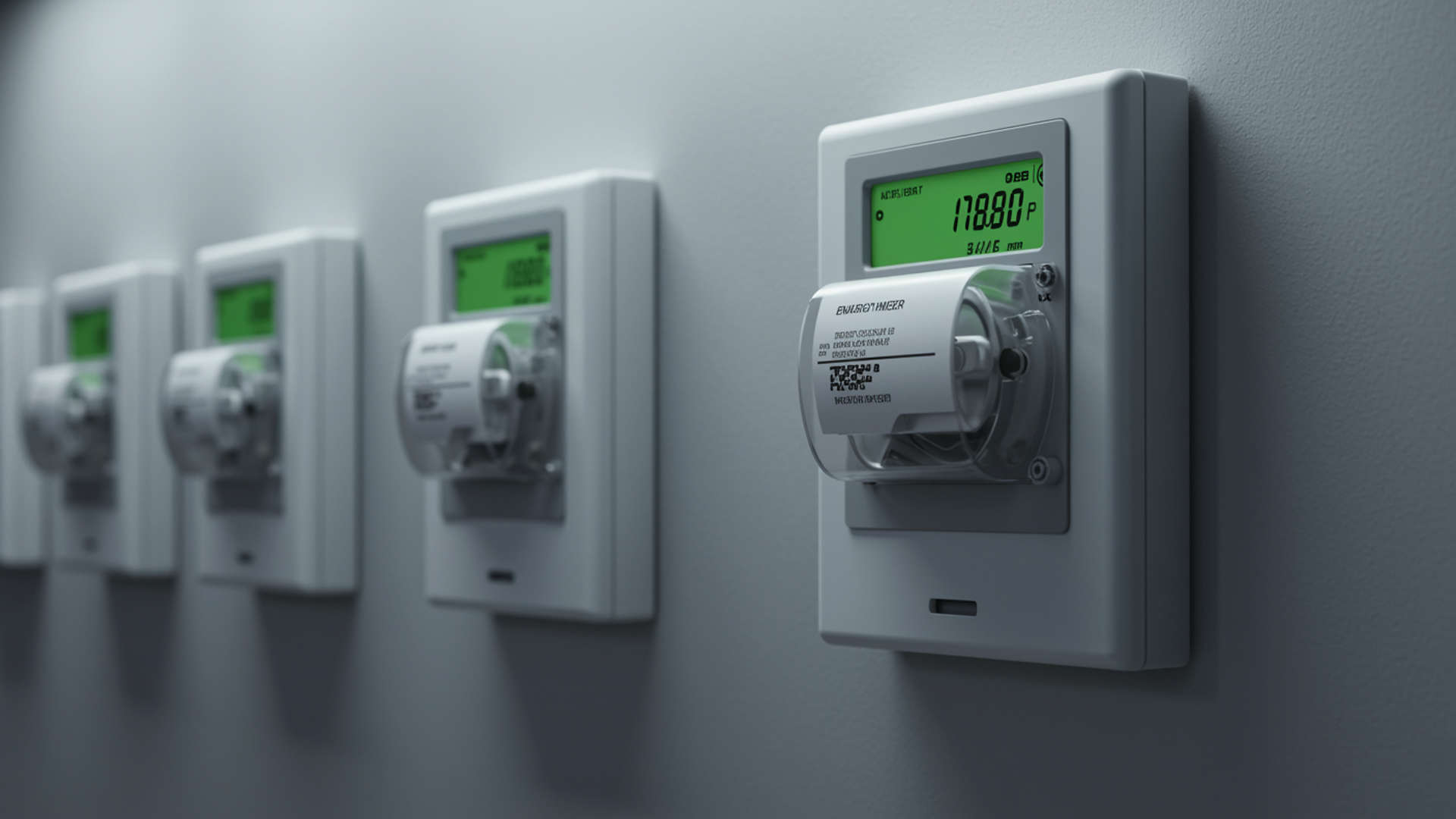Executive Summary
With over 119 million smart energy meters installed in the US by 2022, they are rapidly reshaping U.S. utility operations. Research by Smart Energy International has also shown an 80% penetration of smart meters in the North American region.
For executives and leaders, these digital devices unlock a wide array of outcomes: faster outage response, accurate billing, successful RC/DC operations, reduced losses and streamlined compliance reporting. In this guide, we will explore how utilities can harness smart energy meters to balance opportunity with risks and achieve measurable outcomes.
What Is a Smart Energy Meter?
Smart energy meters are devices that record energy use at regular intervals (e.g. every 15 or 30 minutes). They provide granular-level data, along with supporting bidirectional communication, remote commands (such as RC/DC or firmware updates), and logs events like outages, tamper attempts, or reverse flow. It is now a critical node in an AMI (Advanced Metering Infrastructure) ecosystem, helping utilities achieve unparalleled levels of efficiency, support proactive maintenance and improve consumer satisfaction.
Components of Smart Electricity Meter
To function fully within a modern utility architecture, a smart energy meter system comprises:
Smart Energy Utility Metering: US and North America Adoption Trends
- Research by IoT Analytics have shown that the smart electricity meter penetration in North America stood at 77% by 2023
- A Berg Insight study reveals that the North America Market for smart meters is expected to grow at CAGR of 3.8% from 2023-2029
- To put it numbers, the installed base of smart meters will increase from 145 million to 182.9 million
- As per Fortune Business Insights, the global smart meters market was valued at $25.98 Billion in 2025. It is expected to reach a staggering value of $51.56 Billion by 2032.
How Smart Energy Meters Operate/Work
Smart metering is not just a digital substitutes for analog or traditional meters. They also act as individual data hubs at every point of connection. Smart meters can consistently measure usage, log events, and communicate that data back to the utility. At the same time, they also receive instructions, enabling utilities to observe, decide, and act upon the grid in real time.
Data Lifecycle
All smart energy meters perform in a consistent pattern, such as:
Interval Capture– Consumption data captured at intervals of 15, 30 or 60 minutes.
Local Buffering– Events and data are stored locally in firmware until transmitted
Validation & Flagging– Upon arrival in HES and MDM, data goes through accuracy checks for gaps and duplicates
Estimation/Substitution– In case of missing readings/data, safe algorithms will be executed to fill gaps
Aggregation & Storage– Cleaned data will reside in time series warehouses (daily/monthly sets) for the long-term data needs.
Billing / Analytics Export– Meter data is formatted, as it flows into systems for billing, event tracking and dashboarding/reporting
Commands & Control
With smart meters, energy utilities get access to two-way communication support, which they can use to:
1. Start/stop services remotely (RC/DC)
2. Push tariffs or program updates
3. Activate on-demand reads or firmware updates, reducing dependency on truck rolls
Meter-to-Cash vs Measure-to-Control
Meter-to-Cash means bills that are accurate, timely, and complete.
Measure-to-Control means data should become actionable. Outages or loads must be tracked, or renewables need to be integrated.
.png)
Business Outcomes & KPIs Execs Should Track
Smart energy meters only demonstrate their value when executives can link them to observable and measurable outcomes. Below are the four dimensions of performance that executives may find most significant to utility operations.
Revenue & Assurance
- Billing Completeness (%): This KPI monitors the percentage of actual reads against expected reads within a billing cycle. When billing completeness is high, utilities have the ability to bill their customers for verified consumption instead of relying on estimates. This helps reduce revenue leakage and improve overall consumer trust.
- Estimated bill rate: A high percentage of estimated bills may indicate communication or data issues. Each estimated bill opens the door for potential disputes and late payment. Reducing the percentage of estimated bills facilitates continued cash flow and enhances the customer experience.
- Disputed bill rate: Disputes not only drain away operational resources but can also result in regulatory problems. Tracking disputed bills tied to metering accuracy provides executives with a tool to quantify the true business costs of inaccurate or unaccounted data.
- Theft detection yield: Modern smart energy meters are capable of recording attempts to tamper, reverse flows, or sudden spikes in consumption. A high theft detection yield indicates the AMI (Advanced Metering Infrastructure) system is working to address non-technical losses, and protect utility revenue streams.
Operational Efficiency
- RC/DC success rate (%): This metric measures how reliably utilities are able to remotely connect/disconnect customer supply. With high success rates, utilities can reduce dependency on field crews, speed up service activations, and minimize operational expenses.
- First-time-right installs (%): If there is a failed activation, or an endpoint is incorrectly installed, it will create a delayed billing process, and harm customer confidence. A high first-time-right number reflects smoother deployment operations, and reducing costly follow ups.
- Truck-roll reduction: Each avoided dispatch contributes to hundreds of dollars saved in labor, fuel, and vehicle wear. With successful remote command execution, utilities can scale operations without scaling costs.
- MTTR (Mean Time to Repair): Smart energy meters have the capability to transmit outage signals and restoration confirmations instantly. Reducing MTTR improves reliability indices, like SAIDI/SAIFI, while also boosting regulator and consumer confidence.
Reliability & Planning
- Outage detection time: Traditional systems rely on customer calls; smart meters automatically flag outages within minutes. Faster detection allows utilities to prioritize crews and minimize downtime.
- Restoration confirmation: Smart meters also confirm when services are restored, removing guess work and ensuring accurate reporting. Utilities also get access to the necessary data to assist in reliably reporting restoration and expedite compliance requirements.
- Load profile coverage: With interval data coming from smart meters, demand forecasting becomes more precise. High coverage enables utilities to plan peak load strategies and bring down overall reliance on costly reserves.
- TOU adherence: With time-of-use tariffs becoming more prevalent, utilities must confirm that billing aligns with contracted schedules. Reliable time-of-use adherence helps the utility avoid costly disputes and penalties.
Customer & Compliance
- Complaint rate: Having a lower complaint rate for utilities is an indicator of stronger customer relationships. When utilities are able to address issues related to billing accuracy and outage management, they witness fewer escalations to regulators.
- SLA adherence: Regulators often establish performance thresholds, such as minimum daily read success. Monitoring SLA adherence helps utilities remain compliant, reducing exposure to penalties.
- Audit trail completeness: Smart meters logs every command, reading, and event. A complete audit trail allows utilities to demonstrate compliance to regulators.
- Regulatory report cycle time: Producing timely, accurate reports helps minimize compliance effort and allows utilities to build credibility with regulators. Faster cycle times also gives staff time to focus on operational improvements.

ROI (Return On Investment) & TCO (Total Cost of Ownership) of Smart Electricity Meters
At the executive level, the economics surrounding smart energy meters is the most relevant. The main driver of adoption in smart energy meters is a straightforward comparison between upfront investments and long-term, measurable payback.
Cost Buckets
- Hardware (meters & NICs): The upfront cost of meter devices and their communications modules forms the largest cost. Meters and NICs need to be reliable enough to operate for 10-15 years in the field.
- Communications (RF/cellular): Depending on the geographical distribution, utilities will pay for RF mesh collectors and cellular subscriptions. Costs are typically directly proportionate to coverage density, which directly affects total cost of ownership.
- Platform licenses: HES, MDM, and warehouse analytics tools represent the main core systems to manage smart energy meter data. The licensing and support contracts can frequently represent a significant component of ongoing Opex.
- Infrastructure (storage/compute): Millions of meters generate terabytes of interval data. Storage and compute infrastructure must be provisioned to allow access to relevant data in real-time,
- Field operations: Deployment, maintenance, and troubleshooting of meters and comms equipment are ongoing costs that must be factored into the executive budgeting process.
Cost Savings
- Reduction in losses and theft: Smart energy meters prevent revenue leakage by identifying tampering or suspicious usage patterns. Even a slight decrease in non-technical losses translates to millions of dollars annually.
- Elimination of truck rolls: With remote capabilities, smart meters allow utilities to handle activations, disconnects, and updates without dispatching crews. Each avoided truck roll compounds into significant opex savings at scale.
- Reduced disputes: Verified data results in fewer billing discrepancies and disputes, reducing the burden on consumer support and avoiding legal challenges. With increase in billing accuracy, service providers are also able to enhance consumer trust.
- Improved cash cycles: Interval data allows consumers to have faster bill production and payment, supporting faster cash realisation and improving liquidity for utilities to invest in sustainable, renewable energy and deferring relying on the capital market.
- Faster cash cycles: With time-stamped interval data, bills are generated and settled more quickly. Faster revenue realization improves liquidity and reduces reliance on external financing.
- Managing peak demand: Smart meters interval data allows utilities to build DR (demand response) programs. With this approach, they can encourage consumers to shift their energy use towards off-peak periods. This not only ensures consumers save money but also reduces strain on the grid.
Ultimately, the ROI and TCO of smart energy meters depend on how successfully utilities convert them into measurable savings and efficiencies. When implemented with a strategic blueprint, energy meters demonstrate payback in the form of reduced losses, fewer disputes, and improved cash cycles.
However, it is also key to keep in mind that in addition to these benefits, utilities must also consider the associated risks from smart meters (from cybersecurity to interoperability). Let’s explore some of them in more detail.
%20%26%20TCO.png)
Risks & Myths of Smart Meters (& How to Mitigate)
Along with understanding the benefits of smart meters for electricity, utilities also need to have an honest understanding of risks. Transparent governance strengthens consumer trust and regulatory confidence.
“Are Smart Meters Dangerous?”
A persistent myth often surrounding smart meters is that they emit harmful levels of radiofrequency radiation. However, studies conducted by bodies like the American Cancer Society have shown that smart meters do not really pose a health threat to humans.
That being said, it is still important for utilities to proactively share certified safety documentation to reassure consumers and regulators. Transparency is critical in ensuring that rumours about potential public-relations risk are not spread, impacting consumer trust.
Cybersecurity & Privacy
With smart meters, the digital perimeter of utilities expands. This creates potential new entry points for cyber-attacks. Without proper safeguards, there are risks of data breaches, and financial penalties, all of which impact consumer trust and regulatory adherence.
Some of the best practices include AES-256 encryption, frequent key rotation, RBAC enforcement, and anomaly detection. Moreover, aligning with standards like NERC CIP and vendor certifications like ISO 27001 demonstrates compliance and mitigates cyber risk exposure.
Communications Gaps & Data Quality
Non-communicating meters or delayed communication are everyday operational headaches. If not addressed on time, SLA failures, incomplete billing, and false breach reports.
Utilities must adopt cadence-aware completeness strategies or models. This means establishing frameworks as to how many readings a meter must receive daily (12, 24, 48, 96). This also helps in managing and segregating data profiles, such as daily reads or monthly billing. A cadence aware framework turns noisy gaps into manageable workflows, ensuring meter data completeness.
Vendor Lock-in & Interoperability
Over-dependence on proprietary ecosystems creates long-term inflexibility and inflates costs. Utility leaders must prevent vendor lock-in scenarios by insisting on DLMS/COSEM standards, deploying architecture which is API-first design, and calling for full data export guarantees in RFP's. The goal is to provide flexibility to respond to future market demands, from DER lower costs, integration to advanced analytics.
Grid Case Study: SLA Automation At Scale for Smart Energy Meter Operations
A utility enterprise deployed Grid’s SMOC (smart meter operations center) to manage 400,000+ smart electricity meters transmitting over 19 million data points per day. With Grid, they overcame fragmented, siloed workflows to establish a centralized SLA monitoring and automation framework.
Revenue & Assurance
- Billing accuracy improved with automated daily LP(load profile) and DP (daily profile) checks. This framework ensured meter data completeness at all times for verified billing.
- Any events of SLA breaches in monthly billing profiles were flagged and resolved, reducing delayed or disputed bills.
Operational Efficiency
- The utility achieved a 30% faster response to SLA breaches via auto-task creation and management in external tools like Jira and WFM systems.
- Our built-in BPM engine (Grid Flow) reduced dependency on manual intervention, saving hundreds of truck rolls annually.
Reliability & Planning
- SLA compliance was tracked for 48 LP reads/day per meter, with latency of less than 3 seconds for alerts.
- SAT (Site Acceptance Test) performance dashboards were built on Grid that highlighted failing meters early, preventing downstream billing issues.
Customer & Compliance
- The utility recorded a 20% improvement in field efficiency via automated routing of tasks to the right teams.
- 20+ SLA KPIs are now tracked in near real time, ensuring regulatory adherence and transparent reporting.
In this case study, we see how Grid empowers utilities to leverage smart meter data to not merely monitor performance, but also automate SLA reporting, reduce costs, and deliver measurable outcomes.
Read the full case study here: Redefining Smart Meter SLA Monitoring with Grid SMOC
Conclusion
Both energy and water utility metering have evolved from simple indicators of consumption to valuable assets for utilities. As we have seen in this guide, they ensure data completeness, reduce losses 7 operational discrepancies, and enhance operational responsiveness. That being said, utility leaders must balance the promise of smart energy meters against potential risks to ensure investments improve performance and increase customer confidence.
The lesson is clear. Success is not just in deploying smart electric meters but turning the data they provide into meaningful intelligence. Grid partners with utilities to make this shift possible, transforming smart meter operations into a foundation for resilience, efficiency, and future readiness. For decision-makers seeking how to achieve these outcomes, now is the time to move from measurement to action.
Your smart electric meters are already collecting data. Let us show you how to turn it into verified billing, efficiency, and compliance



.jpg)
.jpg)
.jpg)






